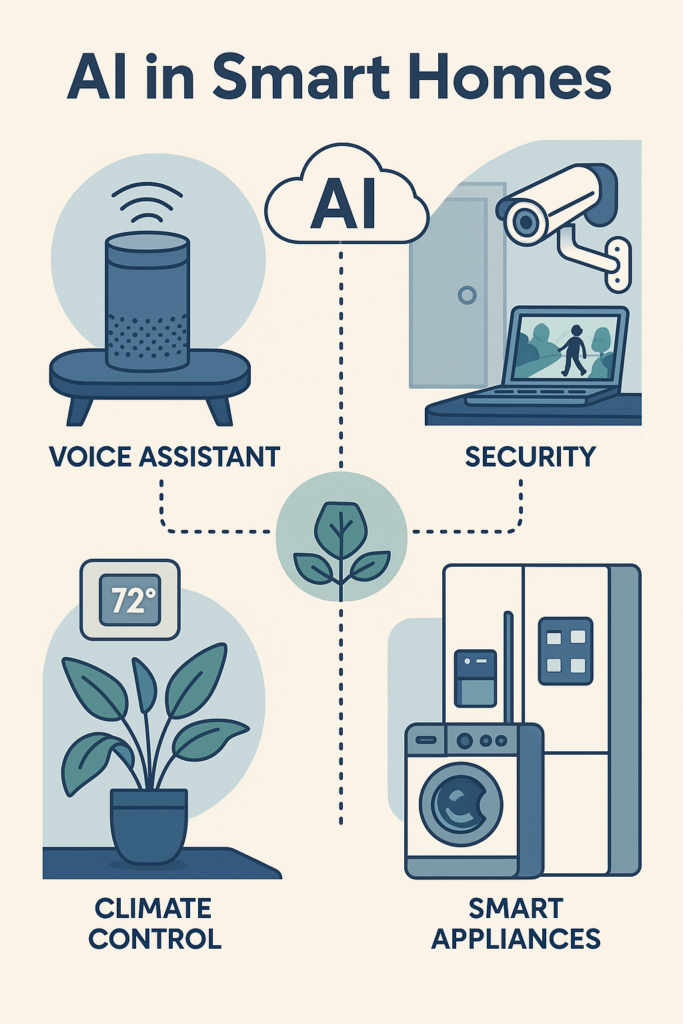Explore how AI is transforming smart homes and IoT devices in 2025. Learn about use cases like voice assistants, smart surveillance, predictive maintenance, and energy optimization.
How Artificial Intelligence Is Powering the Next Generation of Connected Devices
The fusion of AI and the Internet of Things (IoT) is transforming homes into intelligent, adaptive environments. From predictive thermostats to voice-controlled appliances and proactive home security systems, AI is the brain that makes IoT devices smarter, more responsive, and user-centric.
This blog explores how AI is revolutionizing smart home ecosystems, key use cases, technical enablers, and the future of edge intelligence.
🧠 What Makes a Smart Home “Intelligent”?
A traditional smart home connects devices. An AI-powered smart home learns, adapts, and makes autonomous decisions based on patterns, context, and predictions.
Core Characteristics:
- Context Awareness: Understands user behavior and environmental conditions
- Autonomous Decision-Making: Automates actions without manual triggers
- Real-Time Processing: Analyzes sensor data instantly for faster reactions
- Personalization: Adapts device behavior based on user preferences
🏡 Example: A smart thermostat like Google Nest learns your daily routines and optimizes energy use by predicting when to heat or cool the house.

🔌 AI Use Cases in Smart Homes
1. 🔉 Voice Assistants & Natural Language Processing (NLP)
AI enables seamless voice interactions with devices via NLP.
| Examples | Technologies Involved |
|---|---|
| Amazon Alexa, Google Assistant, Apple Siri | Speech recognition, intent detection, dialogue management |
These assistants leverage transformer-based LLMs (e.g., BERT, Whisper, GPT) for more natural conversations and smart context handling.
2. 🌡️ Energy Optimization and Climate Control
Smart thermostats and lighting systems use AI to:
- Predict usage patterns
- Minimize energy waste
- Adjust settings based on presence detection and weather forecasts
⚙️ Example: Ecobee uses occupancy sensors and weather data to dynamically adjust HVAC settings with ML models.
3. 🔐 Smart Security and Surveillance
AI enhances home security through:
- Facial recognition
- Anomaly detection in video feeds
- Predictive alerts and event classification
| Tool | AI Capability |
|---|---|
| Ring, Arlo, Nest Cam | Object/person detection, activity zones |
| Deep Sentinel | Real-time threat analysis via edge AI |
🧠 Computer vision models (like YOLOv5 or MobileNet) power smart cameras with real-time object and face detection.
4. 🧺 Smart Appliances and Predictive Maintenance
Appliances can now:
- Diagnose faults before breakdowns
- Optimize cycles (e.g., washing machines adjusting based on load)
- Send maintenance alerts using embedded ML models
🧼 Example: LG’s AI DD washing machines use motion and fabric detection for optimized washing.
5. 🧠 AI in Home Hubs and Edge Devices
The rise of edge AI chips (like Google Coral, Apple Neural Engine) allows:
- On-device inference without cloud latency
- Enhanced privacy and local autonomy
- Faster decision-making for time-sensitive tasks (e.g., intruder alerts)
⚡ Smart homes are increasingly moving toward edge-centric architectures for low latency and data sovereignty.
🔧 Technical Stack for AI in Smart Homes
| Layer | Technologies Involved |
|---|---|
| Hardware | Sensors, microcontrollers (ESP32, Raspberry Pi), edge AI chips |
| Connectivity | Zigbee, Z-Wave, Wi-Fi, Thread, BLE |
| AI Models | TinyML, NLP models, vision models, federated learning |
| Integration | Home Assistant, SmartThings, Apple HomeKit |
| Cloud + Edge | AWS IoT, Google Cloud IoT Core, Azure IoT Hub |
📡 Privacy, Security & Ethical Considerations
With AI collecting behavioral data at scale, risks include:
- Data privacy breaches
- Unwanted surveillance
- Bias in facial recognition or automation logic
Mitigation Strategies:
- Use on-device processing for sensitive data
- Ensure opt-in consent for data collection
- Regular firmware updates and network security audits
🔒 Privacy-preserving ML techniques like federated learning and differential privacy are increasingly adopted in home ecosystems.
🔮 What’s Next? The Future of AI-Driven Smart Homes
- Emotion-aware environments: Adjust lighting/music based on mood recognition
- Multimodal input fusion: Combine speech, gestures, and vision for seamless control
- Autonomous home agents: AI systems that coordinate multiple devices contextually
- Self-healing systems: AI that detects and fixes network/device failures automatically
📲 Smart homes will evolve into cognitive environments that anticipate and adapt to human needs in real time.
Final Thoughts
AI is redefining smart homes by transforming them from reactive gadget ecosystems into proactive, intelligent assistants. The convergence of deep learning, edge computing, and ubiquitous connectivity is driving an era of truly adaptive living spaces.
As smart devices become more autonomous, secure, and personalized, the AI-powered home will no longer be a luxury—it will become the standard.